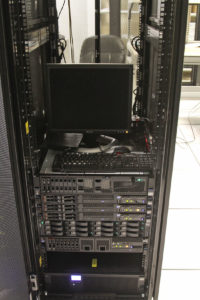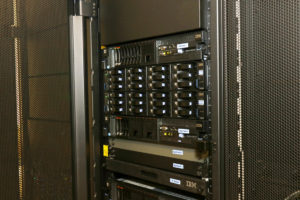
The IT Business Relations Department and the College of Engineering and Computer Science will host High Performance Computing (HPC) workshops today through Wednesday on all the UTRGV campuses.
High Performance Computing refers to the practice of combining computing power in a way that delivers a much higher performance than one could get out of a standard desktop computer in order to solve large problems in science, engineering or business.
Legacy institutions UT Pan American and UT Brownsville became involved with high performance computing in 2006. The university currently has three HPC clusters, Futuro, Bambi and Thumper.

Lesley Robles/ The Rider
“In 2006 is when the first cluster, a Dell cluster, came to the university to do computational chemistry, mathematical simulations,” said Robert Jackson, IT Faculty and Research Support manager. “It was a 55-node cluster.”
A node is an object on a network. They communicate with each other to solve a larger problem than any singular computer could in a reasonable amount of time. A cluster is a set of nodes that work toward a common goal. It can be viewed as a single system.
In 2010, UT Brownsville acquired Futuro, which is a 40-node cluster with a general parallel file system (GPFS) and can be used for computationally intensive calculations and assimilations. In 2011, the Edinburg campus received the 72-node Thumper cluster.
“Say you have a computer node that has 12 CPU [central processing unit] cores, but your program needs 24 cores. You can recruit two nodes to run your computation,” Jackson said. “Therefore, you get a better performance and you’re able to get the computation done quicker than you would if you ran it on your desktop.”
The clusters are used in research conducted by students or staff members who want to run computationally complex applications. For example, Matlab, which is the Matrix Laboratory, is able to function thanks to the clusters, and the Robert C. Vackar College of Business and Entrepreneurship runs a complex simulation to forecast stocks on the stock market.

Today’s workshop will take place at 8:30 a.m. in Academic Services Building 2.148 on the Edinburg campus and will feature a presentation by the Texas Advanced Computing Center (TACC).
“TACC has a huge cluster,” Jackson said. “They run computations for the government, for the Department of Energy and the Department of Defense.”
On Tuesday, an HPC presentation by Dell is scheduled at 8:30 a.m. in Cortez Hall 118.
At 8:30 a.m. Wednesday in Education Complex 2.228 on the Edinburg campus, NVIDIA, a manufacturer of graphical processing units, will give a presentation. At 1:15 p.m., IBM will then give a high performance computing presentation.
“We have a small high performance computing community here and we want to grow it,” Jackson said. “We want to enrich it and make it much bigger. A lot of faculty are doing research and they don’t have the computational capability and they’re just making it the best they can. I want to let them know that this is out there for them to use, for their convenience. There are people here who can help them, set them up, get them going and support them as they go forward.”
For more information about the HPC workshops and to register, visit utrgv.edu/training.






